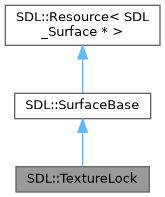Locks a Texture for access to its pixels.
|
|
constexpr | TextureLock ()=default |
| | Creates an empty lock.
|
| |
|
constexpr | TextureLock (TextureLock &&other) |
| | Move constructor.
|
| |
| | TextureLock (TextureRef texture, OptionalRef< const SDL_Rect > rect) |
| | Lock a portion of the texture for write-only pixel access.
|
| |
| | ~TextureLock () |
| | Destructor.
|
| |
| void | Unlock () |
| | Unlock a texture, uploading the changes to video memory, if needed.
|
| |
|
void | reset () |
| | Same as Unlock(), just for uniformity.
|
| |
|
constexpr | LockBase ()=default |
| | Default ctor.
|
| |
|
| LockBase (const LockBase &other)=delete |
| |
|
| LockBase (LockBase &&other) |
| | Move ctor.
|
| |
|
constexpr | ~LockBase () |
| | Dtor.
|
| |
|
LockBase & | operator= (LockBase other) |
| | Move assignment.
|
| |
|
RESOURCE | release () |
| | Returns reference and reset this.
|
| |
|
constexpr | operator bool () const |
| | Check if not null.
|
| |
|
constexpr bool | operator== (const ResourcePtrBase &other) const |
| | Comparison.
|
| |
|
constexpr bool | operator== (std::nullptr_t) const |
| | Comparison.
|
| |
|
constexpr bool | operator== (std::nullopt_t) const |
| | Comparison.
|
| |
|
constexpr reference | operator* () const |
| | Gets reference.
|
| |
|
constexpr const reference * | operator-> () const |
| | Gets addressable reference.
|
| |
|
constexpr reference * | operator-> () |
| | Gets addressable reference.
|
| |
|
reference | get () const |
| | Get reference.
|
| |
|
|
using | deleter = DELETER |
| | The deleter type.
|
| |
|
using | reference = RESOURCE |
| | The reference resource type.
|
| |
|
using | value_type = typename reference::value_type |
| | The raw resource type.
|
| |
|
constexpr | LockBase (SurfaceRef &&resource) |
| | Constructs initializing member.
|
| |
|
constexpr | ResourceOwnerBase (base::value_type value={}, DELETER deleter={}) |
| | Constructs from raw type.
|
| |
|
void | free () |
| | Frees resource.
|
| |
|
constexpr | ResourcePtrBase (value_type value={}) |
| | Constructs from raw type.
|
| |
|
reference & | get () |
| | Get reference.
|
| |
◆ TextureLock()
As an optimization, the pixels made available for editing don't necessarily contain the old texture data. This is a write-only operation, and if you need to keep a copy of the texture data you should do that at the application level.
You must use TextureLock.Unlock() to unlock the pixels and apply any changes.
- Parameters
-
| texture | the texture to lock for access, which was created with TEXTUREACCESS_STREAMING. |
| rect | an Rect structure representing the area to lock for access; nullptr to lock the entire texture. |
- Exceptions
-
- Thread safety:
- This function should only be called on the main thread.
- Since
- This function is available since SDL 3.2.0.
- See also
- TextureLock.Unlock
◆ ~TextureLock()
| SDL::TextureLock::~TextureLock |
( |
| ) |
|
|
inline |
◆ Unlock()
| void SDL::TextureLock::Unlock |
( |
| ) |
|
|
inline |
Warning: Please note that TextureRef.Lock() is intended to be write-only; it will not guarantee the previous contents of the texture will be provided. You must fully initialize any area of a texture that you lock before unlocking it, as the pixels might otherwise be uninitialized memory.
Which is to say: locking and immediately unlocking a texture can result in corrupted textures, depending on the renderer in use.
- Thread safety:
- This function should only be called on the main thread.
- Since
- This function is available since SDL 3.2.0.
- See also
- TextureRef.Lock
The documentation for this class was generated from the following file:

 Public Member Functions inherited from SDL::LockBase< SurfaceRef >
Public Member Functions inherited from SDL::LockBase< SurfaceRef > Public Member Functions inherited from SDL::ResourceOwnerBase< RESOURCE, DELETER >
Public Member Functions inherited from SDL::ResourceOwnerBase< RESOURCE, DELETER > Public Member Functions inherited from SDL::ResourcePtrBase< RESOURCE >
Public Member Functions inherited from SDL::ResourcePtrBase< RESOURCE > Public Types inherited from SDL::ResourceOwnerBase< RESOURCE, DELETER >
Public Types inherited from SDL::ResourceOwnerBase< RESOURCE, DELETER > Public Types inherited from SDL::ResourcePtrBase< RESOURCE >
Public Types inherited from SDL::ResourcePtrBase< RESOURCE > Protected Member Functions inherited from SDL::LockBase< SurfaceRef >
Protected Member Functions inherited from SDL::LockBase< SurfaceRef > Protected Member Functions inherited from SDL::ResourceOwnerBase< RESOURCE, DELETER >
Protected Member Functions inherited from SDL::ResourceOwnerBase< RESOURCE, DELETER > Protected Member Functions inherited from SDL::ResourcePtrBase< RESOURCE >
Protected Member Functions inherited from SDL::ResourcePtrBase< RESOURCE >